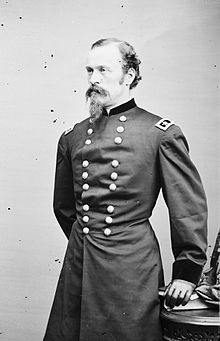James H. Wilson
James Harrison Wilson | |
|---|---|
 Portrait of James Wilson during the Civil War | |
| Born | September 2, 1837 Shawneetown, Illinois |
| Died | February 23, 1925 (aged 87) Wilmington, Delaware |
| Place of burial | Old Swedes Churchyard, Wilmington, Delaware |
| Allegiance | United States of America Union |
| Service/ | United States Army Union Army |
| Years of service | 1860–1870, 1898–1901 |
| Rank | |
| Commands held | Western Cavalry Corps |
| Battles/wars | American Civil War Spanish–American War Boxer Rebellion |
| Relations | Jim Thompson (grandson) |
James Harrison Wilson (September 2, 1837 – February 23, 1925) was a
Returning to the Western Theater, Wilson became one of the few Union commanders to defeat Confederate cavalier
Early life and engineering
Wilson was born in
Civil War
Engineering assignments
After the start of the Civil War, Wilson received promotions to second and
Wilson was transferred to the
Cavalry commands

In 1864, Wilson switched from engineering to the
General Wilson's ill-fated joint adventure with General Brigadier General
However, just before Sheridan's decisive Battle of Cedar Creek in October 1864, Wilson was upgraded to brevet major general of volunteers and transferred back to the West to become chief of cavalry for the Military Division of the Mississippi under Sherman.
As cavalry chief, he trained Sherman's cavalry (under
In many particulars the Federal soldiers acted very cleverly. Gen. [James H.] Wilson turned over to Gen. Ira Foster the Confederate mules, horses, wagons, and harness, for distribution to the poor, and Col. J.H.R Washington of Macon, was associated with Gen. Foster to aid in the distribution.[2][3]
On June 24, 1865, in General Order #31, General Wilson expressed appreciation to Foster and Washington, and relieved them of their authority, placing the task with Capt. R. Carter, A.Q.M., Cavalry Corps Military Division of the Mississippi.[4]
At the end of the war, Wilson reverted to the rank of lieutenant colonel and was assigned to the newly created 35th U.S. Infantry, but his duty assignments continued to be in the Corps of Engineers until he resigned from the Army in December 1870.
Later life and wars
After he left the Army, Wilson worked as a railroad construction engineer and executive. He moved to Wilmington, Delaware, in 1883. For the next 15 years he devoted his time to business, travel, and public affairs, and wrote on a number of subjects.
Wilson returned to the Army in 1898 for the
He was a Veteran Companion of the District of Columbia Commander of the Military Order of the Loyal Legion of the United States (MOLLUS) – a military society of Union officers and their descendants. He was assigned MOLLUS insignia number 12106.
Wilson died in Wilmington, Delaware, in 1925, with only three Union Civil War generals living longer.[5] He is buried in the Old Swedes Churchyard in Wilmington.
Works
- The Life of General U. S. Grant, General of the Armies of the United States (co-authored with Charles A. Dana, 1868)
- China: Travels and Investigations in the Middle Kingdom—a Study of its Civilization and Possibilities, with a Glance at Japan (1887)
- Life and Services of Brevet Brigadier-General Andrew Jonathan Alexander, United States Army (1887)
- Heroes of the Great Conflict: Life and Services of William Farrar Smith, Major General, United States Volunteers in the Civil War (1904)
- The Life of Charles A. Dana (1907)
- The Campaign of Chancellorsville (1911)
- Under the Old Flag: Recollections of Military Operations in the War for the Union, the Spanish War, the Boxer Rebellion, etc. (1912)
- The Life of John A. Rawlins: Lawyer, Assistant Adjutant-General, Chief of Staff, Major General of Volunteers, and Secretary of War (1916)
See also
- List of American Civil War Generals (Union)
- Puerto Rican Campaign
Notes
- ^ Center, Jr., Clark E (2008). "University of Alabama". Encyclopedia of Alabama. Auburn University. Retrieved December 6, 2011.
- ^ United States. War Dept; Robert Nicholson Scott; Henry Martyn Lazelle; et al. (1897). The War of the Rebellion: A Compilation of the Official Records of the Union and Confederate Armies. U.S. Government Printing Office. pp. 631–632.
- ISBN 978-1-153-49287-4.
- ^ New York Times (16 July 1865). "The Cotton in Georgia.; IMPORTANT ORDER BY GEN. WILSON". The New York Times. Retrieved 26 October 2013.
- ^ Warner, p. 568. Union Generals Nelson A. Miles, John R. Brooke, and Adelbert Ames lived longer.
References
- Eicher, John H., and ISBN 0-8047-3641-3.
- Warner, Ezra J. Generals in Blue: Lives of the Union Commanders. Baton Rouge: Louisiana State University Press, 1964. ISBN 0-8071-0822-7.
- Library of Congress biography of Wilson
- Chisholm, Hugh, ed. (1911). . Encyclopædia Britannica. Vol. 28 (11th ed.). Cambridge University Press. p. 695.
